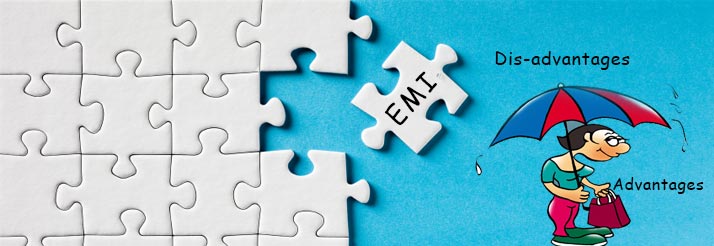An EMI Equated Monthly Installment is a financial term used in loan repayments. It’s a quick and easy method to pay off any type of loan. When a borrower takes a loan from a bank or NBFC, the repayment of the loan is done mainly in specific monthly installments. These fixed financial installments are known as EMIs. The amount of EMI is dependent on the principal loan amount, tenure and the interest rate. This monthly installment or EMI amount is supposed to be paid on a fixed date to the bank by cheque or by electronically.
There are a few advantages and disadvantages to the whole EMI scheme one should consider before opting for the same.
Advantages of EMI:
Freedom to Buy Expensive Utilities: EMI gives a chance to consumers to buy expensive utilities which they won’t be able to buy otherwise. Be it expensive household items, a vehicle, gifts and jewellery for wedding or a house itself, EMI helps you buy anything and everything. As consumers get a chance to divide the amount in monthly installments and pay it off easily, they make the purchase and enjoy the benefits. This gives an advantage to not only buyers of such expensive utilities but also to the traders and sellers. EMIs are like a wishing bone for common man.
Easy on Wallets: The borrower can pay the loan in monthly installments by opting EMI scheme. The amount is determined on the basis of principal loan amount, tenure, interest rate and the borrower’s ability of repayment. This makes it easier for the borrowers to pay off the said amount in small chunks every month. Thus they don’t have to pinch their monthly expenses to afford various expensive utilities.
Flexible EMI Options by Banks: Many banks now-a-days offer flexible EMI options to the borrowers. The EMIs are adjusted and decided as per the borrower’s needs. The installment and tenure is decided by the borrower as per his or her convenience.
Disadvantages of EMI:
Longer Debts: The borrowers have to pay the monthly installments or EMIs until they are done with the principal amount and the applicable interest rate. In terms of home loans or personal loan these tenures go as long as 20 to 30 years. That means a borrower spends nearly half of his or her life repaying the loan installments. This restricts the borrower from buying any other such luxurious utilities in near future.
No Early Repayment: If a borrower wishes to pay back the loan faster than anticipated by using extra savings or a bonus, banks do not offer an easy option to do so. Many banks and NBFCs charge an early repayment fees to such borrowers. This makes it difficult for the borrowers to pay off the loan earlier even if they could.
Charges on Skipping EMIs: If a borrower forgets or misses to pay the said EMI on or by the given date, banks and NBFCs charge the borrower with late fees. Banks and NBFCs have strict terms when it comes to repayment through EMIs. Skipping multiple EMIs may lead the borrower to face legal action or their collateral can be taken away by the bank.
Extra Costs: The borrower has to pay extra amount than the actual borrowed amount in form of interest rate. As the principal amount and interest rates are combined to form an EMI, the borrower can’t avoid paying this extra amount.









